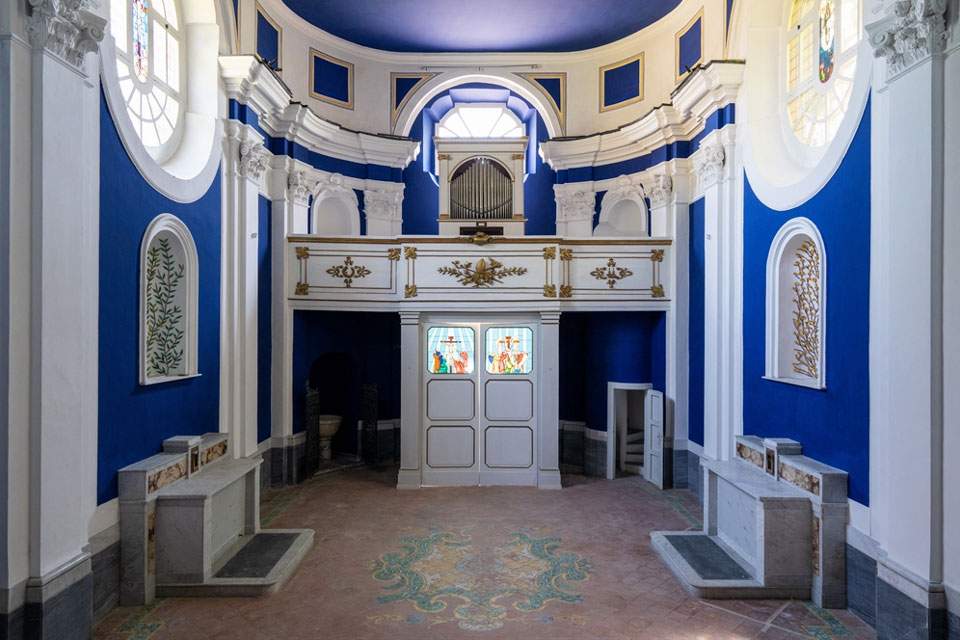Architect Santiago Calatrava has created asite-specific installation for the Church of San Gennaro in the Real Bosco di Capodimonte, built in 1745 by architect and stage designer Ferdinando Sanfelice at the behest of Charles of Bourbon. Calatrava has accomplished inside the 18th-century Baroque chapel atotal work of art, completely reinterpreting it: from the stained glass windows to the ceiling, the niches, the new lighting, and the new furnishings. For the intervention, titled In the Light of Naples and visible until Aug. 22, 2021, Calatrava made San Leucio silks as altar hangings and porcelain vases during workshops with students and master artisans from the Caselli-De Sanctis Rare Institute/Real Fabbrica di Capodimonte.
The installation is designed to be a “living work” using the human hand, represented inlocal crafts (weaving, porcelain, glazing and painting), where the skill of the human hand gives a living character to the work. Here Calatrava wanted to bring together the traditional artifacts and crafts of the Campania region. “Those historical artifacts are the light of Naples and are brought together in a modern installation within an eighteenth-century environment,” said the renowned architect. "Contemporary vocabulary is incorporated in a historical context that enhances its meaning. The walls and ceiling have been painted an intense ultramarine blue to highlight the structural and ornamental elements of the chapel and give it a greater sense of depth. The installation allows for the creation of an overall concept(Gesamtkunstwerk) in which different arts (ceramics, weaving, glazing, painting, etc.) converge into an autonomous work that speaks from the past to the present to the future."
The contemporary installation, promoted by the Capodimonte Museum and Real Bosco di Capodimonte, is composed of several interventions in dialogue with each other, with different materials and different craftsmen present in the productive fabric of Campania (Tessuti d’Arte di San Leucio, Istituto ad indirizzo raro Caselli-De Sanctis/ Real Fabbrica di Capodimonte, master glassmaker Antonio Perotti of Vietri sul Mare, iGuzzini for the lighting and engineering firm Avino for the direction and coordination of works). The entire installation and every single piece that makes it up were designed pro bono by Santiago Calatrava and will enrich the collections of the Capodimonte Museum and Real Bosco.
Master ceramists and students from the Real Fabbrica di Capodimonte made, based on original designs by Calatrava, the porcelain stars for the ceiling of the chapel and the flowers, leaves and branches that adorn the two side niches: the one on the right draws a golden cross of leaves on a bed of green leaves and the one on the left draws a cross composed of red flowers on a bed of yellow ochre flowers. The three pairs of vases to be placed on the central altar and side altars, the candle holders for the altars, the porcelain angels and doves to be placed in the niche housing the baptistery with the baptismal font, and a ceramic egg that hangs down from the ceiling to the church’s high altar were also made here.
Master glazier Antonio Perotti of Vietri sul Mare made stained glass windows for the chapel, using the ancient technique of lead-stitching, from original designs by Calatrava of sacred inspiration: Crucifixion and Deposition for the entrance drum, Resurrection and Ascension for the two side rose windows using a handcrafted, high-color-radiation cobalt blue glass as the bottom of the rose window. For the side doors leading into the sacristy, on the other hand, four stained glass windows were made with leaves and berries.
 |
| An 18th-century Baroque chapel completely transformed: it is Calatrava's total work |
Warning: the translation into English of the original Italian article was created using automatic tools. We undertake to review all articles, but we do not guarantee the total absence of inaccuracies in the translation due to the program. You can find the original by clicking on the ITA button. If you find any mistake,please contact us.